Analysis of Health Promotion Models and Government Strategies
VerifiedAdded on 2020/09/08
|18
|4768
|120
Report
AI Summary
This report delves into the multifaceted realm of health promotion, commencing with an examination of Dahlgren and Whitehead's determinants of health model, which elucidates the socio-economic influences on health. It then identifies and assesses key government reports, such as the Black Report and the Marmot Review, to understand health inequalities. The report further explores Tudor-Hart's concept of the inverse care law. Task 2 explains two health promotion models (Ecological and Health Belief Models) and examines government health strategies at the regional level, alongside the roles of health professionals and the importance of routines. Task 3 focuses on the health belief model, the transtheoretical model of health behavior, and the influence of political beliefs on health promotion strategies, concluding with the relevance of health information dissemination. The report offers a comprehensive overview of health promotion principles, models, and their practical applications.
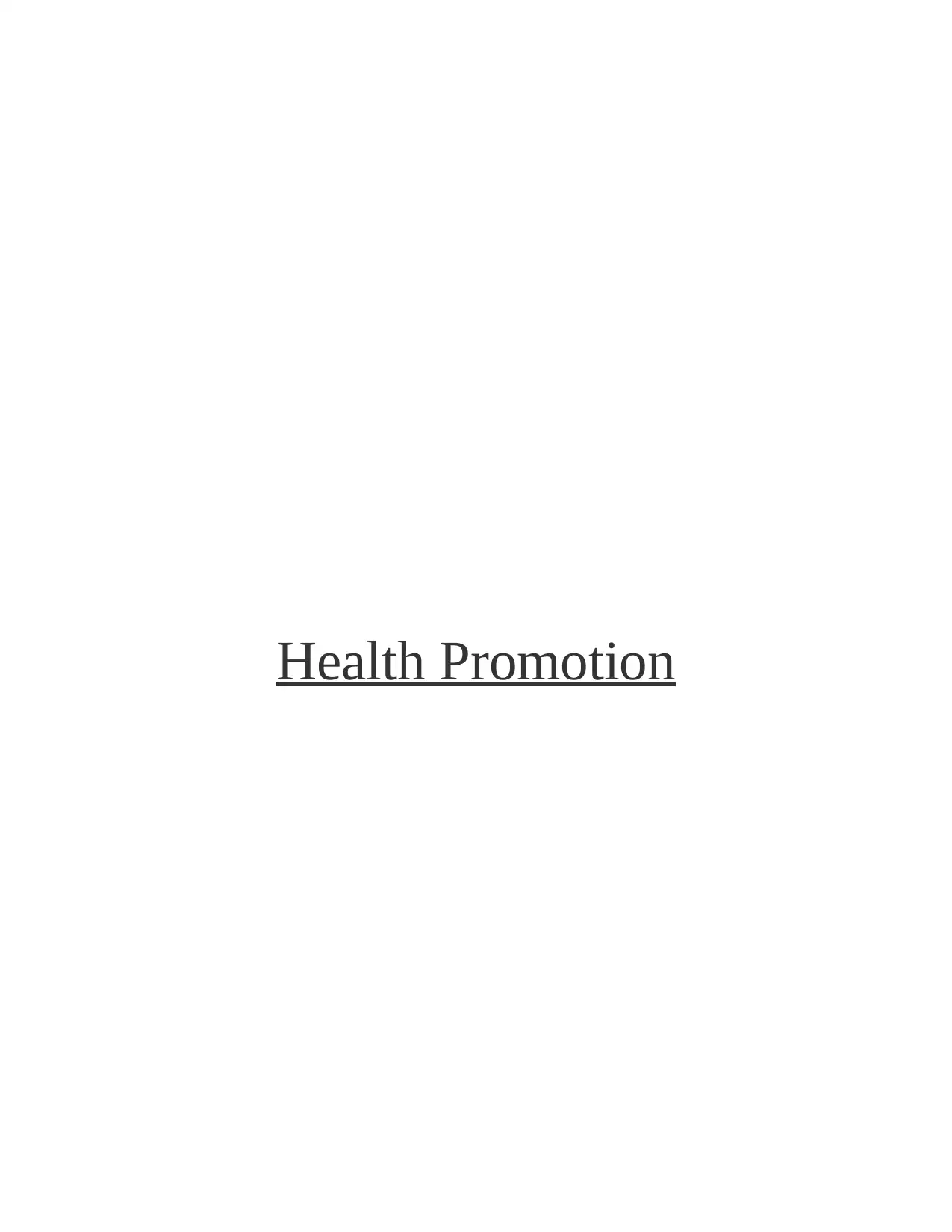
Health Promotion
Paraphrase This Document
Need a fresh take? Get an instant paraphrase of this document with our AI Paraphraser
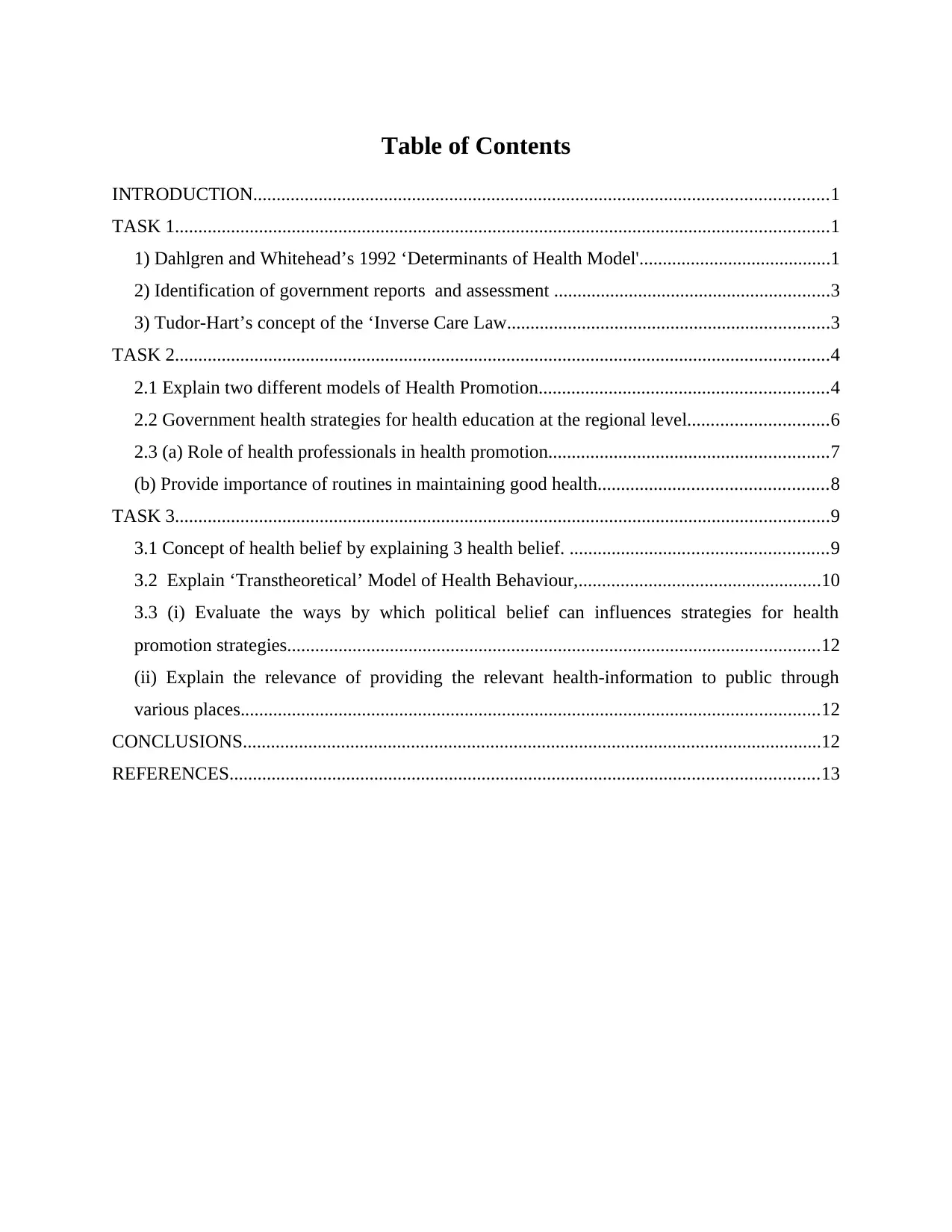
Table of Contents
INTRODUCTION...........................................................................................................................1
TASK 1............................................................................................................................................1
1) Dahlgren and Whitehead’s 1992 ‘Determinants of Health Model'.........................................1
2) Identification of government reports and assessment ...........................................................3
3) Tudor-Hart’s concept of the ‘Inverse Care Law.....................................................................3
TASK 2............................................................................................................................................4
2.1 Explain two different models of Health Promotion..............................................................4
2.2 Government health strategies for health education at the regional level..............................6
2.3 (a) Role of health professionals in health promotion............................................................7
(b) Provide importance of routines in maintaining good health.................................................8
TASK 3............................................................................................................................................9
3.1 Concept of health belief by explaining 3 health belief. .......................................................9
3.2 Explain ‘Transtheoretical’ Model of Health Behaviour,....................................................10
3.3 (i) Evaluate the ways by which political belief can influences strategies for health
promotion strategies..................................................................................................................12
(ii) Explain the relevance of providing the relevant health-information to public through
various places............................................................................................................................12
CONCLUSIONS............................................................................................................................12
REFERENCES..............................................................................................................................13
INTRODUCTION...........................................................................................................................1
TASK 1............................................................................................................................................1
1) Dahlgren and Whitehead’s 1992 ‘Determinants of Health Model'.........................................1
2) Identification of government reports and assessment ...........................................................3
3) Tudor-Hart’s concept of the ‘Inverse Care Law.....................................................................3
TASK 2............................................................................................................................................4
2.1 Explain two different models of Health Promotion..............................................................4
2.2 Government health strategies for health education at the regional level..............................6
2.3 (a) Role of health professionals in health promotion............................................................7
(b) Provide importance of routines in maintaining good health.................................................8
TASK 3............................................................................................................................................9
3.1 Concept of health belief by explaining 3 health belief. .......................................................9
3.2 Explain ‘Transtheoretical’ Model of Health Behaviour,....................................................10
3.3 (i) Evaluate the ways by which political belief can influences strategies for health
promotion strategies..................................................................................................................12
(ii) Explain the relevance of providing the relevant health-information to public through
various places............................................................................................................................12
CONCLUSIONS............................................................................................................................12
REFERENCES..............................................................................................................................13
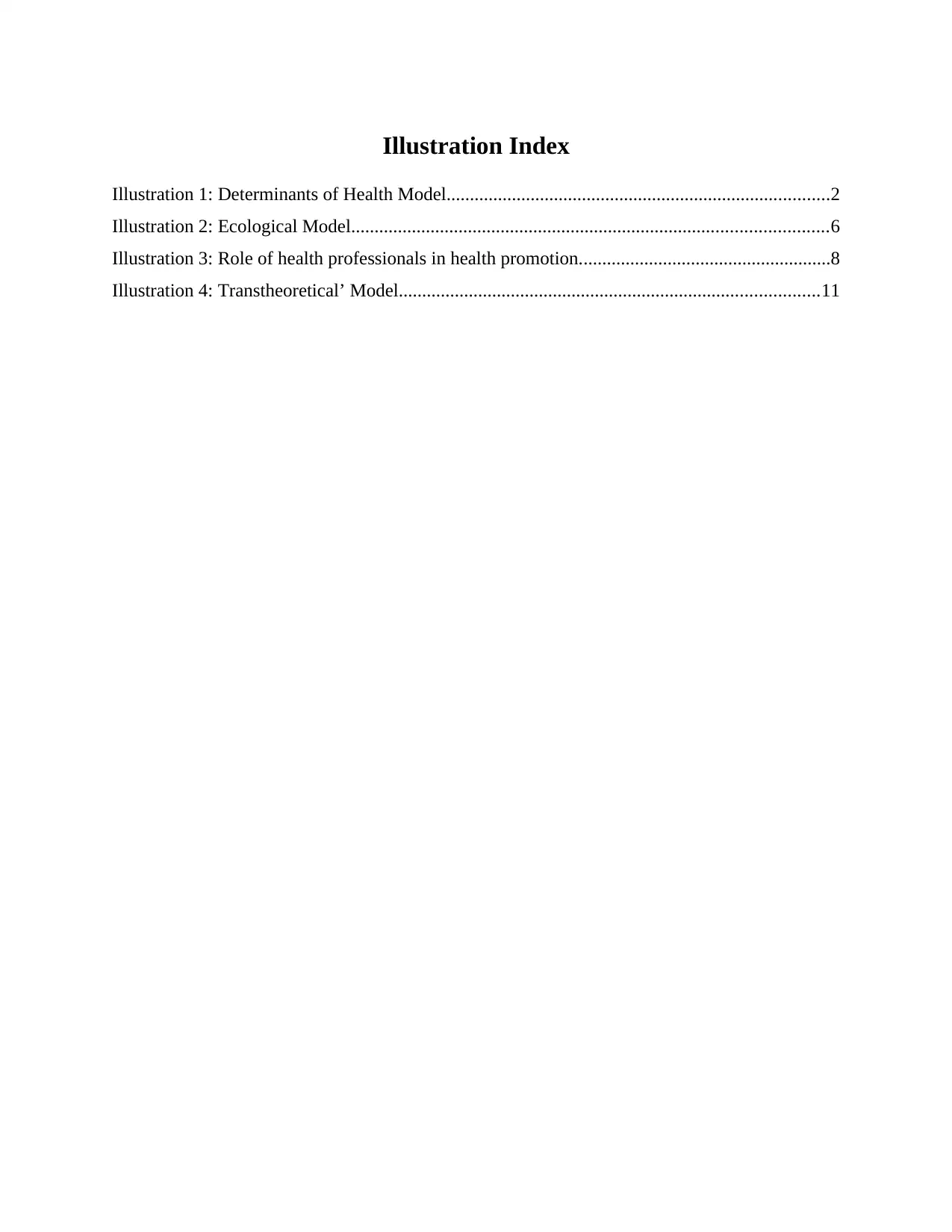
Illustration Index
Illustration 1: Determinants of Health Model..................................................................................2
Illustration 2: Ecological Model......................................................................................................6
Illustration 3: Role of health professionals in health promotion......................................................8
Illustration 4: Transtheoretical’ Model..........................................................................................11
Illustration 1: Determinants of Health Model..................................................................................2
Illustration 2: Ecological Model......................................................................................................6
Illustration 3: Role of health professionals in health promotion......................................................8
Illustration 4: Transtheoretical’ Model..........................................................................................11
⊘ This is a preview!⊘
Do you want full access?
Subscribe today to unlock all pages.

Trusted by 1+ million students worldwide
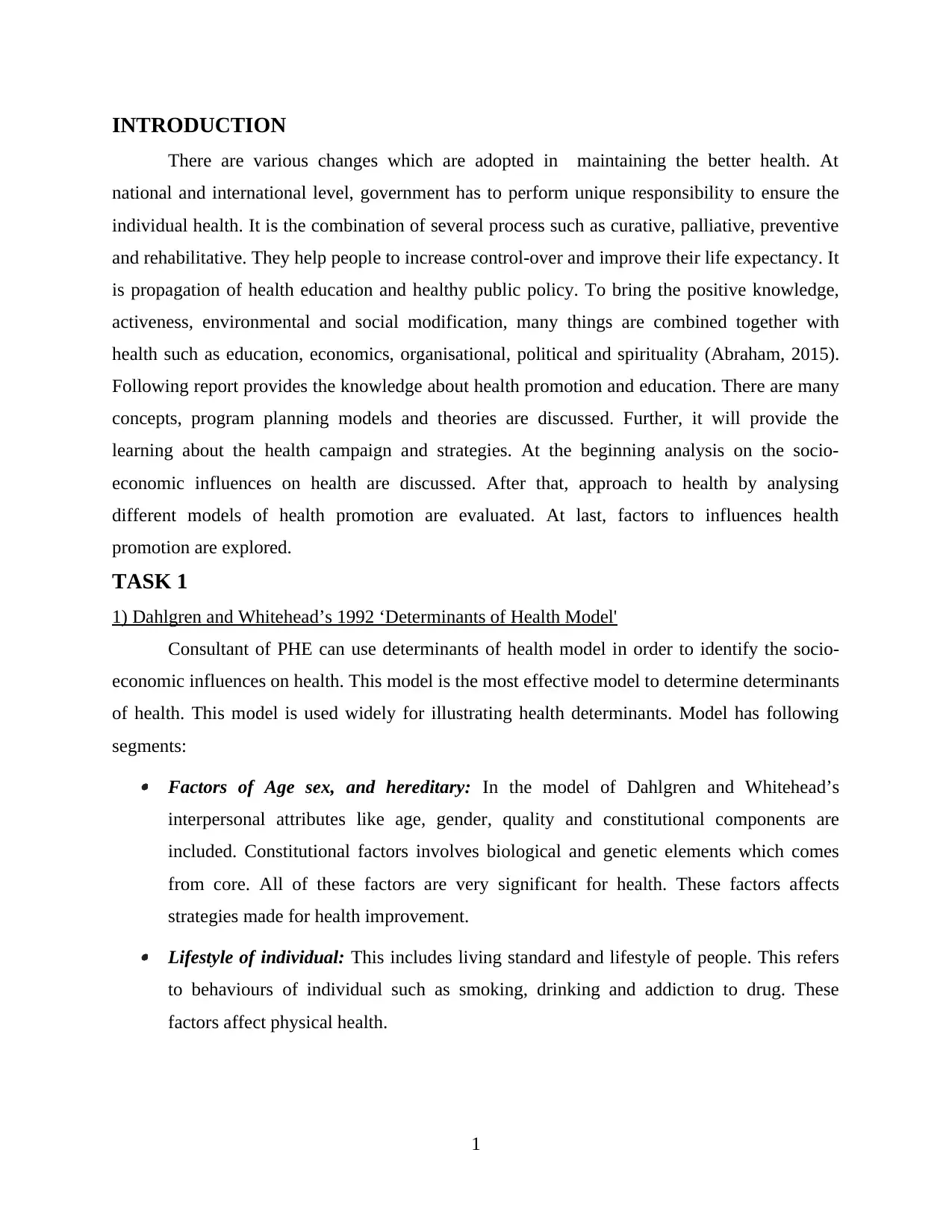
INTRODUCTION
There are various changes which are adopted in maintaining the better health. At
national and international level, government has to perform unique responsibility to ensure the
individual health. It is the combination of several process such as curative, palliative, preventive
and rehabilitative. They help people to increase control-over and improve their life expectancy. It
is propagation of health education and healthy public policy. To bring the positive knowledge,
activeness, environmental and social modification, many things are combined together with
health such as education, economics, organisational, political and spirituality (Abraham, 2015).
Following report provides the knowledge about health promotion and education. There are many
concepts, program planning models and theories are discussed. Further, it will provide the
learning about the health campaign and strategies. At the beginning analysis on the socio-
economic influences on health are discussed. After that, approach to health by analysing
different models of health promotion are evaluated. At last, factors to influences health
promotion are explored.
TASK 1
1) Dahlgren and Whitehead’s 1992 ‘Determinants of Health Model'
Consultant of PHE can use determinants of health model in order to identify the socio-
economic influences on health. This model is the most effective model to determine determinants
of health. This model is used widely for illustrating health determinants. Model has following
segments: Factors of Age sex, and hereditary: In the model of Dahlgren and Whitehead’s
interpersonal attributes like age, gender, quality and constitutional components are
included. Constitutional factors involves biological and genetic elements which comes
from core. All of these factors are very significant for health. These factors affects
strategies made for health improvement. Lifestyle of individual: This includes living standard and lifestyle of people. This refers
to behaviours of individual such as smoking, drinking and addiction to drug. These
factors affect physical health.
1
There are various changes which are adopted in maintaining the better health. At
national and international level, government has to perform unique responsibility to ensure the
individual health. It is the combination of several process such as curative, palliative, preventive
and rehabilitative. They help people to increase control-over and improve their life expectancy. It
is propagation of health education and healthy public policy. To bring the positive knowledge,
activeness, environmental and social modification, many things are combined together with
health such as education, economics, organisational, political and spirituality (Abraham, 2015).
Following report provides the knowledge about health promotion and education. There are many
concepts, program planning models and theories are discussed. Further, it will provide the
learning about the health campaign and strategies. At the beginning analysis on the socio-
economic influences on health are discussed. After that, approach to health by analysing
different models of health promotion are evaluated. At last, factors to influences health
promotion are explored.
TASK 1
1) Dahlgren and Whitehead’s 1992 ‘Determinants of Health Model'
Consultant of PHE can use determinants of health model in order to identify the socio-
economic influences on health. This model is the most effective model to determine determinants
of health. This model is used widely for illustrating health determinants. Model has following
segments: Factors of Age sex, and hereditary: In the model of Dahlgren and Whitehead’s
interpersonal attributes like age, gender, quality and constitutional components are
included. Constitutional factors involves biological and genetic elements which comes
from core. All of these factors are very significant for health. These factors affects
strategies made for health improvement. Lifestyle of individual: This includes living standard and lifestyle of people. This refers
to behaviours of individual such as smoking, drinking and addiction to drug. These
factors affect physical health.
1
Paraphrase This Document
Need a fresh take? Get an instant paraphrase of this document with our AI Paraphraser
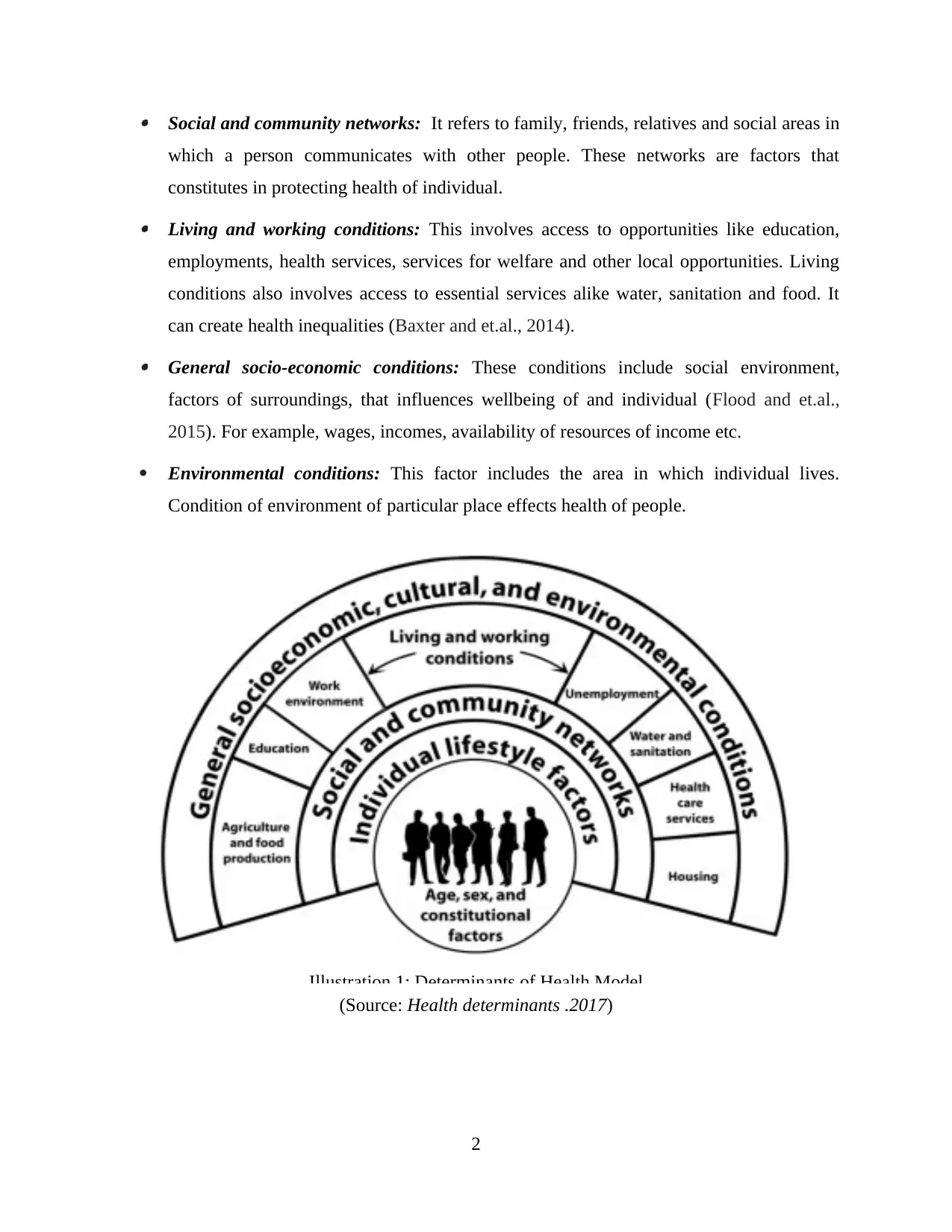
Social and community networks: It refers to family, friends, relatives and social areas in
which a person communicates with other people. These networks are factors that
constitutes in protecting health of individual. Living and working conditions: This involves access to opportunities like education,
employments, health services, services for welfare and other local opportunities. Living
conditions also involves access to essential services alike water, sanitation and food. It
can create health inequalities (Baxter and et.al., 2014). General socio-economic conditions: These conditions include social environment,
factors of surroundings, that influences wellbeing of and individual (Flood and et.al.,
2015). For example, wages, incomes, availability of resources of income etc.
Environmental conditions: This factor includes the area in which individual lives.
Condition of environment of particular place effects health of people.
(Source: Health determinants .2017)
2
Illustration 1: Determinants of Health Model
which a person communicates with other people. These networks are factors that
constitutes in protecting health of individual. Living and working conditions: This involves access to opportunities like education,
employments, health services, services for welfare and other local opportunities. Living
conditions also involves access to essential services alike water, sanitation and food. It
can create health inequalities (Baxter and et.al., 2014). General socio-economic conditions: These conditions include social environment,
factors of surroundings, that influences wellbeing of and individual (Flood and et.al.,
2015). For example, wages, incomes, availability of resources of income etc.
Environmental conditions: This factor includes the area in which individual lives.
Condition of environment of particular place effects health of people.
(Source: Health determinants .2017)
2
Illustration 1: Determinants of Health Model
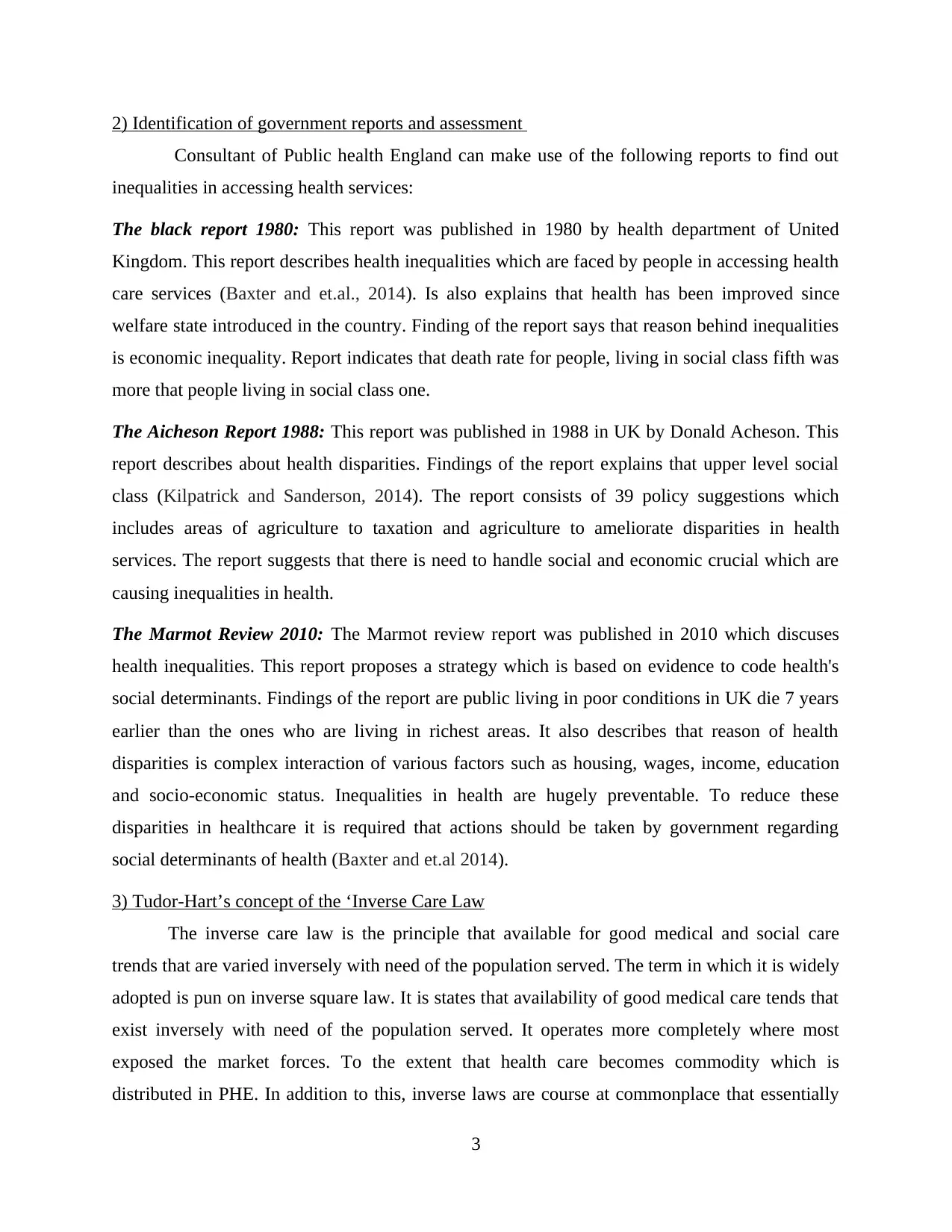
2) Identification of government reports and assessment
Consultant of Public health England can make use of the following reports to find out
inequalities in accessing health services:
The black report 1980: This report was published in 1980 by health department of United
Kingdom. This report describes health inequalities which are faced by people in accessing health
care services (Baxter and et.al., 2014). Is also explains that health has been improved since
welfare state introduced in the country. Finding of the report says that reason behind inequalities
is economic inequality. Report indicates that death rate for people, living in social class fifth was
more that people living in social class one.
The Aicheson Report 1988: This report was published in 1988 in UK by Donald Acheson. This
report describes about health disparities. Findings of the report explains that upper level social
class (Kilpatrick and Sanderson, 2014). The report consists of 39 policy suggestions which
includes areas of agriculture to taxation and agriculture to ameliorate disparities in health
services. The report suggests that there is need to handle social and economic crucial which are
causing inequalities in health.
The Marmot Review 2010: The Marmot review report was published in 2010 which discuses
health inequalities. This report proposes a strategy which is based on evidence to code health's
social determinants. Findings of the report are public living in poor conditions in UK die 7 years
earlier than the ones who are living in richest areas. It also describes that reason of health
disparities is complex interaction of various factors such as housing, wages, income, education
and socio-economic status. Inequalities in health are hugely preventable. To reduce these
disparities in healthcare it is required that actions should be taken by government regarding
social determinants of health (Baxter and et.al 2014).
3) Tudor-Hart’s concept of the ‘Inverse Care Law
The inverse care law is the principle that available for good medical and social care
trends that are varied inversely with need of the population served. The term in which it is widely
adopted is pun on inverse square law. It is states that availability of good medical care tends that
exist inversely with need of the population served. It operates more completely where most
exposed the market forces. To the extent that health care becomes commodity which is
distributed in PHE. In addition to this, inverse laws are course at commonplace that essentially
3
Consultant of Public health England can make use of the following reports to find out
inequalities in accessing health services:
The black report 1980: This report was published in 1980 by health department of United
Kingdom. This report describes health inequalities which are faced by people in accessing health
care services (Baxter and et.al., 2014). Is also explains that health has been improved since
welfare state introduced in the country. Finding of the report says that reason behind inequalities
is economic inequality. Report indicates that death rate for people, living in social class fifth was
more that people living in social class one.
The Aicheson Report 1988: This report was published in 1988 in UK by Donald Acheson. This
report describes about health disparities. Findings of the report explains that upper level social
class (Kilpatrick and Sanderson, 2014). The report consists of 39 policy suggestions which
includes areas of agriculture to taxation and agriculture to ameliorate disparities in health
services. The report suggests that there is need to handle social and economic crucial which are
causing inequalities in health.
The Marmot Review 2010: The Marmot review report was published in 2010 which discuses
health inequalities. This report proposes a strategy which is based on evidence to code health's
social determinants. Findings of the report are public living in poor conditions in UK die 7 years
earlier than the ones who are living in richest areas. It also describes that reason of health
disparities is complex interaction of various factors such as housing, wages, income, education
and socio-economic status. Inequalities in health are hugely preventable. To reduce these
disparities in healthcare it is required that actions should be taken by government regarding
social determinants of health (Baxter and et.al 2014).
3) Tudor-Hart’s concept of the ‘Inverse Care Law
The inverse care law is the principle that available for good medical and social care
trends that are varied inversely with need of the population served. The term in which it is widely
adopted is pun on inverse square law. It is states that availability of good medical care tends that
exist inversely with need of the population served. It operates more completely where most
exposed the market forces. To the extent that health care becomes commodity which is
distributed in PHE. In addition to this, inverse laws are course at commonplace that essentially
3
⊘ This is a preview!⊘
Do you want full access?
Subscribe today to unlock all pages.

Trusted by 1+ million students worldwide
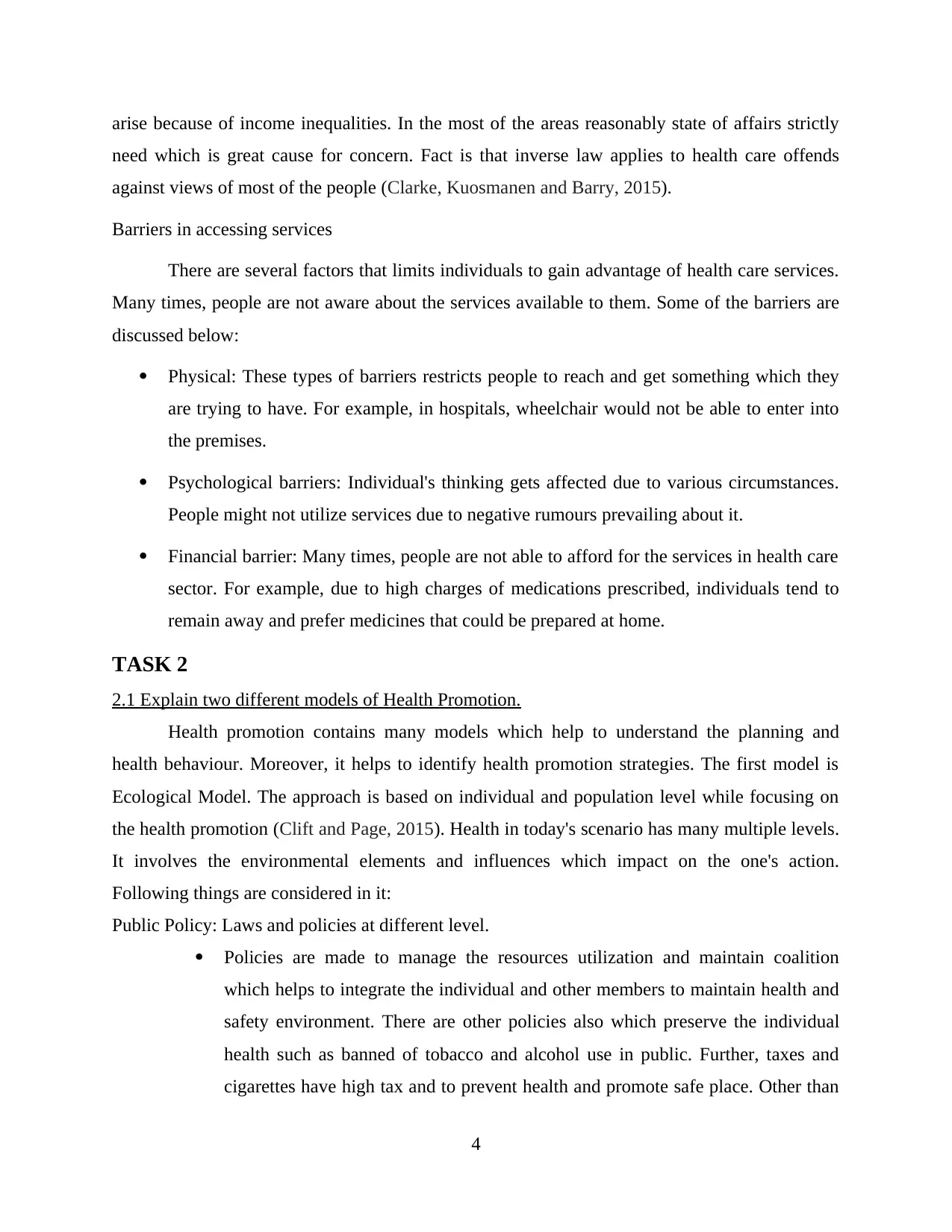
arise because of income inequalities. In the most of the areas reasonably state of affairs strictly
need which is great cause for concern. Fact is that inverse law applies to health care offends
against views of most of the people (Clarke, Kuosmanen and Barry, 2015).
Barriers in accessing services
There are several factors that limits individuals to gain advantage of health care services.
Many times, people are not aware about the services available to them. Some of the barriers are
discussed below:
Physical: These types of barriers restricts people to reach and get something which they
are trying to have. For example, in hospitals, wheelchair would not be able to enter into
the premises.
Psychological barriers: Individual's thinking gets affected due to various circumstances.
People might not utilize services due to negative rumours prevailing about it.
Financial barrier: Many times, people are not able to afford for the services in health care
sector. For example, due to high charges of medications prescribed, individuals tend to
remain away and prefer medicines that could be prepared at home.
TASK 2
2.1 Explain two different models of Health Promotion.
Health promotion contains many models which help to understand the planning and
health behaviour. Moreover, it helps to identify health promotion strategies. The first model is
Ecological Model. The approach is based on individual and population level while focusing on
the health promotion (Clift and Page, 2015). Health in today's scenario has many multiple levels.
It involves the environmental elements and influences which impact on the one's action.
Following things are considered in it:
Public Policy: Laws and policies at different level.
Policies are made to manage the resources utilization and maintain coalition
which helps to integrate the individual and other members to maintain health and
safety environment. There are other policies also which preserve the individual
health such as banned of tobacco and alcohol use in public. Further, taxes and
cigarettes have high tax and to prevent health and promote safe place. Other than
4
need which is great cause for concern. Fact is that inverse law applies to health care offends
against views of most of the people (Clarke, Kuosmanen and Barry, 2015).
Barriers in accessing services
There are several factors that limits individuals to gain advantage of health care services.
Many times, people are not aware about the services available to them. Some of the barriers are
discussed below:
Physical: These types of barriers restricts people to reach and get something which they
are trying to have. For example, in hospitals, wheelchair would not be able to enter into
the premises.
Psychological barriers: Individual's thinking gets affected due to various circumstances.
People might not utilize services due to negative rumours prevailing about it.
Financial barrier: Many times, people are not able to afford for the services in health care
sector. For example, due to high charges of medications prescribed, individuals tend to
remain away and prefer medicines that could be prepared at home.
TASK 2
2.1 Explain two different models of Health Promotion.
Health promotion contains many models which help to understand the planning and
health behaviour. Moreover, it helps to identify health promotion strategies. The first model is
Ecological Model. The approach is based on individual and population level while focusing on
the health promotion (Clift and Page, 2015). Health in today's scenario has many multiple levels.
It involves the environmental elements and influences which impact on the one's action.
Following things are considered in it:
Public Policy: Laws and policies at different level.
Policies are made to manage the resources utilization and maintain coalition
which helps to integrate the individual and other members to maintain health and
safety environment. There are other policies also which preserve the individual
health such as banned of tobacco and alcohol use in public. Further, taxes and
cigarettes have high tax and to prevent health and promote safe place. Other than
4
Paraphrase This Document
Need a fresh take? Get an instant paraphrase of this document with our AI Paraphraser
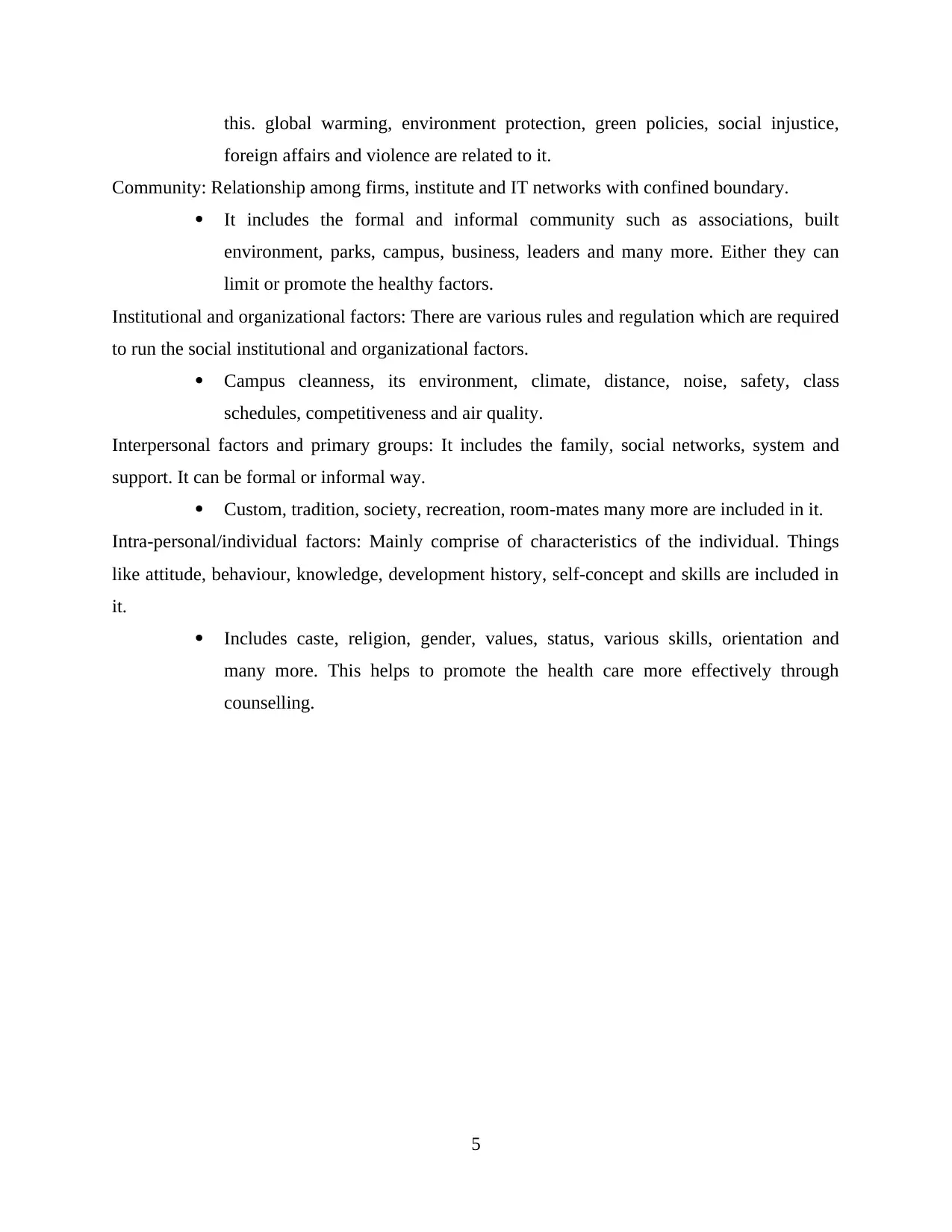
this. global warming, environment protection, green policies, social injustice,
foreign affairs and violence are related to it.
Community: Relationship among firms, institute and IT networks with confined boundary.
It includes the formal and informal community such as associations, built
environment, parks, campus, business, leaders and many more. Either they can
limit or promote the healthy factors.
Institutional and organizational factors: There are various rules and regulation which are required
to run the social institutional and organizational factors.
Campus cleanness, its environment, climate, distance, noise, safety, class
schedules, competitiveness and air quality.
Interpersonal factors and primary groups: It includes the family, social networks, system and
support. It can be formal or informal way.
Custom, tradition, society, recreation, room-mates many more are included in it.
Intra-personal/individual factors: Mainly comprise of characteristics of the individual. Things
like attitude, behaviour, knowledge, development history, self-concept and skills are included in
it.
Includes caste, religion, gender, values, status, various skills, orientation and
many more. This helps to promote the health care more effectively through
counselling.
5
foreign affairs and violence are related to it.
Community: Relationship among firms, institute and IT networks with confined boundary.
It includes the formal and informal community such as associations, built
environment, parks, campus, business, leaders and many more. Either they can
limit or promote the healthy factors.
Institutional and organizational factors: There are various rules and regulation which are required
to run the social institutional and organizational factors.
Campus cleanness, its environment, climate, distance, noise, safety, class
schedules, competitiveness and air quality.
Interpersonal factors and primary groups: It includes the family, social networks, system and
support. It can be formal or informal way.
Custom, tradition, society, recreation, room-mates many more are included in it.
Intra-personal/individual factors: Mainly comprise of characteristics of the individual. Things
like attitude, behaviour, knowledge, development history, self-concept and skills are included in
it.
Includes caste, religion, gender, values, status, various skills, orientation and
many more. This helps to promote the health care more effectively through
counselling.
5
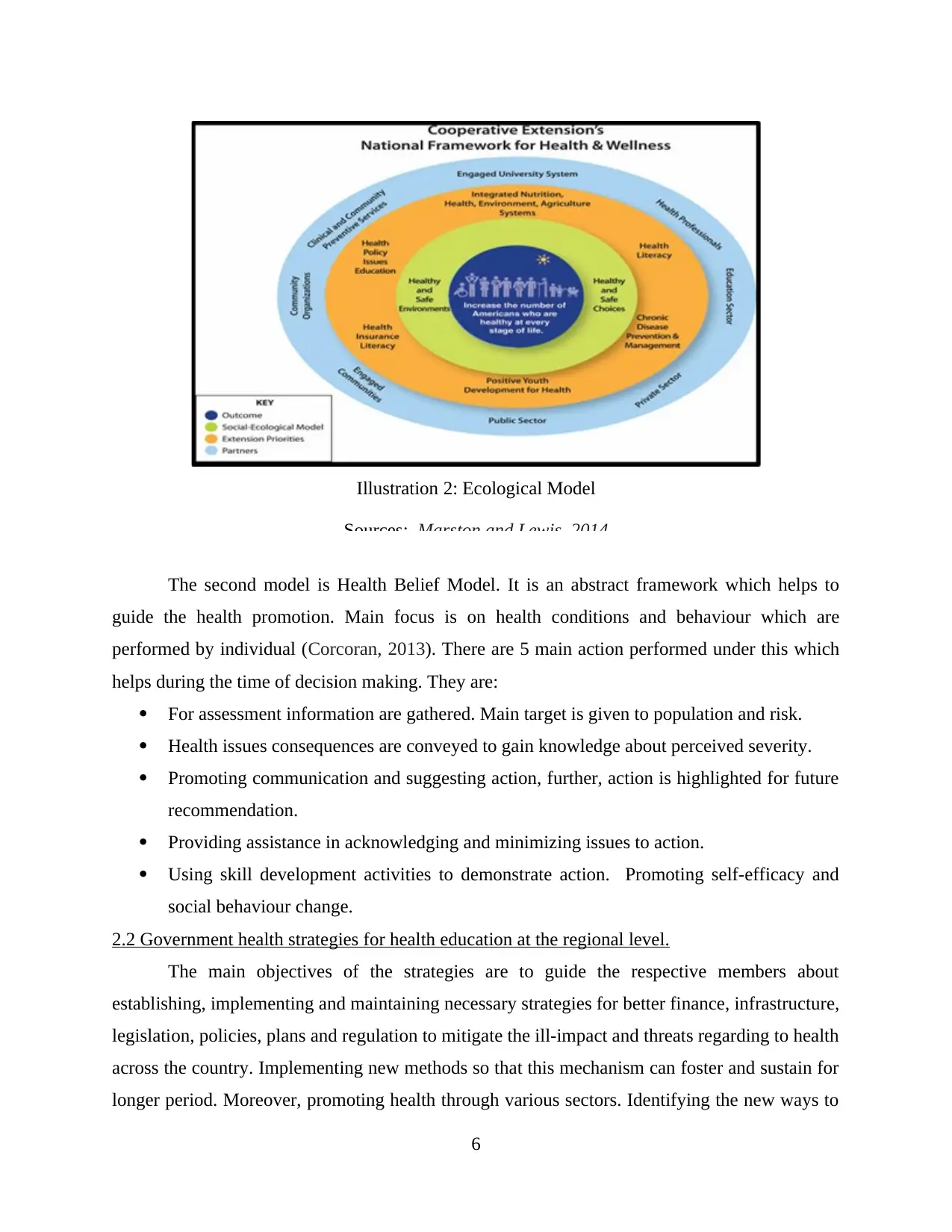
The second model is Health Belief Model. It is an abstract framework which helps to
guide the health promotion. Main focus is on health conditions and behaviour which are
performed by individual (Corcoran, 2013). There are 5 main action performed under this which
helps during the time of decision making. They are:
For assessment information are gathered. Main target is given to population and risk.
Health issues consequences are conveyed to gain knowledge about perceived severity.
Promoting communication and suggesting action, further, action is highlighted for future
recommendation.
Providing assistance in acknowledging and minimizing issues to action.
Using skill development activities to demonstrate action. Promoting self-efficacy and
social behaviour change.
2.2 Government health strategies for health education at the regional level.
The main objectives of the strategies are to guide the respective members about
establishing, implementing and maintaining necessary strategies for better finance, infrastructure,
legislation, policies, plans and regulation to mitigate the ill-impact and threats regarding to health
across the country. Implementing new methods so that this mechanism can foster and sustain for
longer period. Moreover, promoting health through various sectors. Identifying the new ways to
6
Illustration 2: Ecological Model
Sources: Marston and Lewis, 2014
guide the health promotion. Main focus is on health conditions and behaviour which are
performed by individual (Corcoran, 2013). There are 5 main action performed under this which
helps during the time of decision making. They are:
For assessment information are gathered. Main target is given to population and risk.
Health issues consequences are conveyed to gain knowledge about perceived severity.
Promoting communication and suggesting action, further, action is highlighted for future
recommendation.
Providing assistance in acknowledging and minimizing issues to action.
Using skill development activities to demonstrate action. Promoting self-efficacy and
social behaviour change.
2.2 Government health strategies for health education at the regional level.
The main objectives of the strategies are to guide the respective members about
establishing, implementing and maintaining necessary strategies for better finance, infrastructure,
legislation, policies, plans and regulation to mitigate the ill-impact and threats regarding to health
across the country. Implementing new methods so that this mechanism can foster and sustain for
longer period. Moreover, promoting health through various sectors. Identifying the new ways to
6
Illustration 2: Ecological Model
Sources: Marston and Lewis, 2014
⊘ This is a preview!⊘
Do you want full access?
Subscribe today to unlock all pages.

Trusted by 1+ million students worldwide
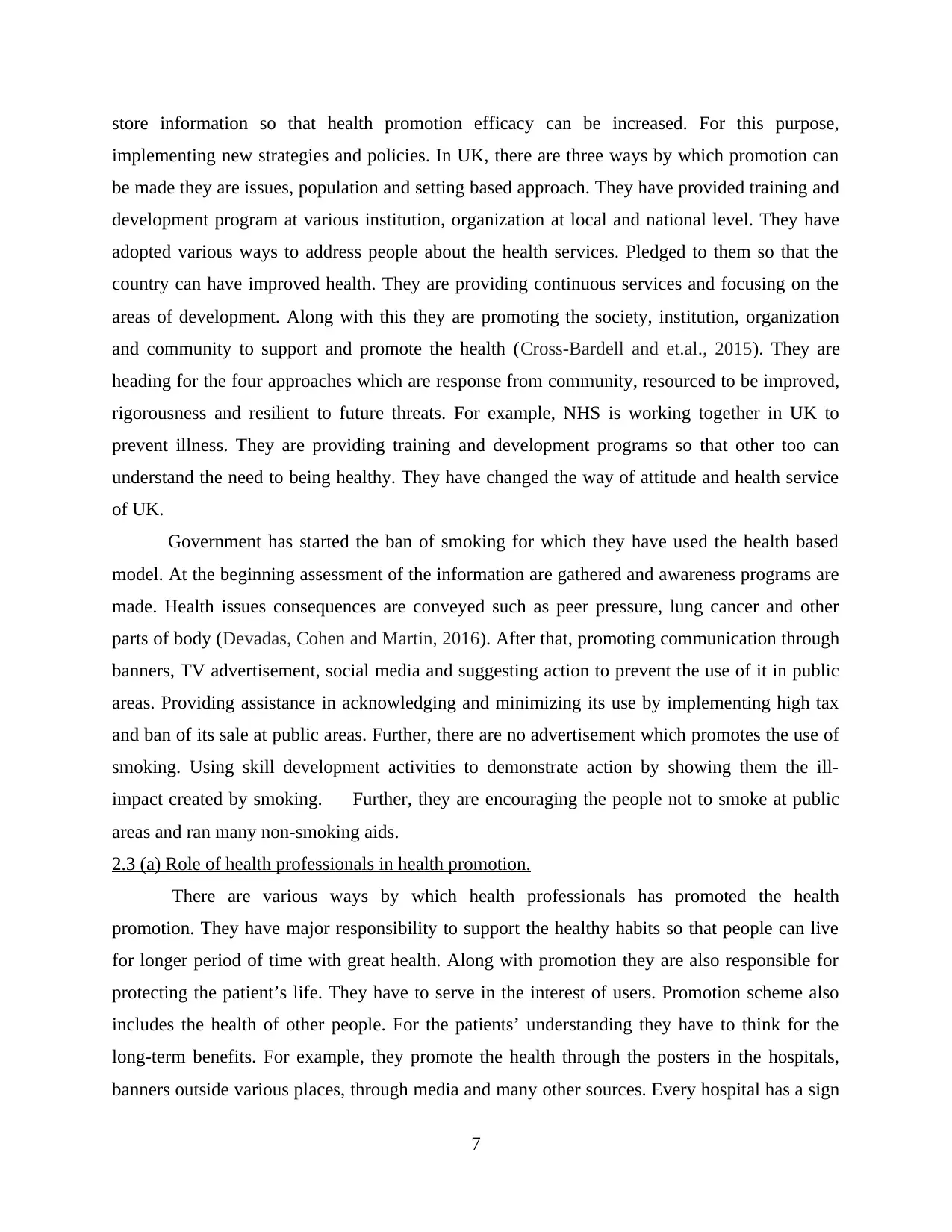
store information so that health promotion efficacy can be increased. For this purpose,
implementing new strategies and policies. In UK, there are three ways by which promotion can
be made they are issues, population and setting based approach. They have provided training and
development program at various institution, organization at local and national level. They have
adopted various ways to address people about the health services. Pledged to them so that the
country can have improved health. They are providing continuous services and focusing on the
areas of development. Along with this they are promoting the society, institution, organization
and community to support and promote the health (Cross-Bardell and et.al., 2015). They are
heading for the four approaches which are response from community, resourced to be improved,
rigorousness and resilient to future threats. For example, NHS is working together in UK to
prevent illness. They are providing training and development programs so that other too can
understand the need to being healthy. They have changed the way of attitude and health service
of UK.
Government has started the ban of smoking for which they have used the health based
model. At the beginning assessment of the information are gathered and awareness programs are
made. Health issues consequences are conveyed such as peer pressure, lung cancer and other
parts of body (Devadas, Cohen and Martin, 2016). After that, promoting communication through
banners, TV advertisement, social media and suggesting action to prevent the use of it in public
areas. Providing assistance in acknowledging and minimizing its use by implementing high tax
and ban of its sale at public areas. Further, there are no advertisement which promotes the use of
smoking. Using skill development activities to demonstrate action by showing them the ill-
impact created by smoking. Further, they are encouraging the people not to smoke at public
areas and ran many non-smoking aids.
2.3 (a) Role of health professionals in health promotion.
There are various ways by which health professionals has promoted the health
promotion. They have major responsibility to support the healthy habits so that people can live
for longer period of time with great health. Along with promotion they are also responsible for
protecting the patient’s life. They have to serve in the interest of users. Promotion scheme also
includes the health of other people. For the patients’ understanding they have to think for the
long-term benefits. For example, they promote the health through the posters in the hospitals,
banners outside various places, through media and many other sources. Every hospital has a sign
7
implementing new strategies and policies. In UK, there are three ways by which promotion can
be made they are issues, population and setting based approach. They have provided training and
development program at various institution, organization at local and national level. They have
adopted various ways to address people about the health services. Pledged to them so that the
country can have improved health. They are providing continuous services and focusing on the
areas of development. Along with this they are promoting the society, institution, organization
and community to support and promote the health (Cross-Bardell and et.al., 2015). They are
heading for the four approaches which are response from community, resourced to be improved,
rigorousness and resilient to future threats. For example, NHS is working together in UK to
prevent illness. They are providing training and development programs so that other too can
understand the need to being healthy. They have changed the way of attitude and health service
of UK.
Government has started the ban of smoking for which they have used the health based
model. At the beginning assessment of the information are gathered and awareness programs are
made. Health issues consequences are conveyed such as peer pressure, lung cancer and other
parts of body (Devadas, Cohen and Martin, 2016). After that, promoting communication through
banners, TV advertisement, social media and suggesting action to prevent the use of it in public
areas. Providing assistance in acknowledging and minimizing its use by implementing high tax
and ban of its sale at public areas. Further, there are no advertisement which promotes the use of
smoking. Using skill development activities to demonstrate action by showing them the ill-
impact created by smoking. Further, they are encouraging the people not to smoke at public
areas and ran many non-smoking aids.
2.3 (a) Role of health professionals in health promotion.
There are various ways by which health professionals has promoted the health
promotion. They have major responsibility to support the healthy habits so that people can live
for longer period of time with great health. Along with promotion they are also responsible for
protecting the patient’s life. They have to serve in the interest of users. Promotion scheme also
includes the health of other people. For the patients’ understanding they have to think for the
long-term benefits. For example, they promote the health through the posters in the hospitals,
banners outside various places, through media and many other sources. Every hospital has a sign
7
Paraphrase This Document
Need a fresh take? Get an instant paraphrase of this document with our AI Paraphraser
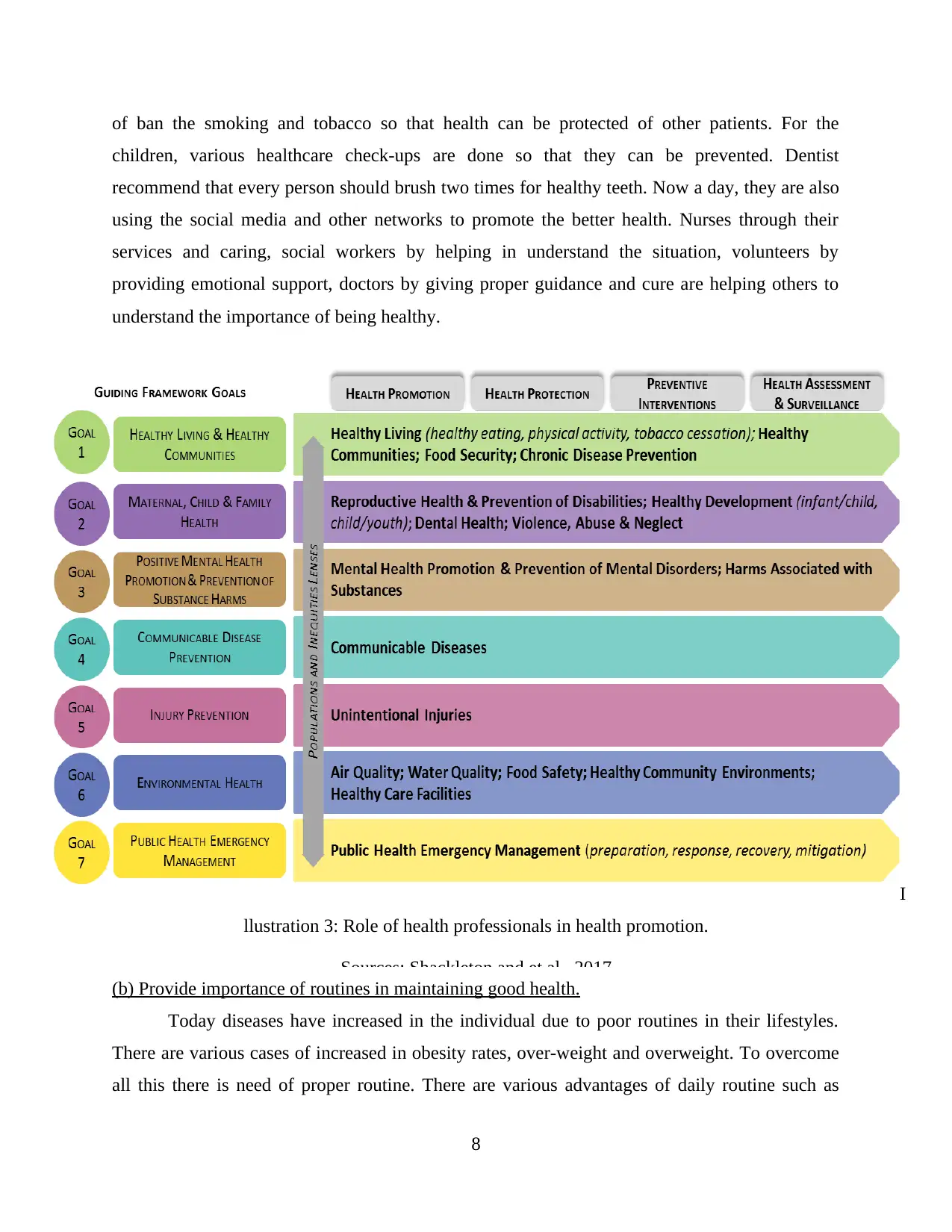
of ban the smoking and tobacco so that health can be protected of other patients. For the
children, various healthcare check-ups are done so that they can be prevented. Dentist
recommend that every person should brush two times for healthy teeth. Now a day, they are also
using the social media and other networks to promote the better health. Nurses through their
services and caring, social workers by helping in understand the situation, volunteers by
providing emotional support, doctors by giving proper guidance and cure are helping others to
understand the importance of being healthy.
(b) Provide importance of routines in maintaining good health.
Today diseases have increased in the individual due to poor routines in their lifestyles.
There are various cases of increased in obesity rates, over-weight and overweight. To overcome
all this there is need of proper routine. There are various advantages of daily routine such as
8
I
llustration 3: Role of health professionals in health promotion.
Sources: Shackleton and et.al., 2017
children, various healthcare check-ups are done so that they can be prevented. Dentist
recommend that every person should brush two times for healthy teeth. Now a day, they are also
using the social media and other networks to promote the better health. Nurses through their
services and caring, social workers by helping in understand the situation, volunteers by
providing emotional support, doctors by giving proper guidance and cure are helping others to
understand the importance of being healthy.
(b) Provide importance of routines in maintaining good health.
Today diseases have increased in the individual due to poor routines in their lifestyles.
There are various cases of increased in obesity rates, over-weight and overweight. To overcome
all this there is need of proper routine. There are various advantages of daily routine such as
8
I
llustration 3: Role of health professionals in health promotion.
Sources: Shackleton and et.al., 2017
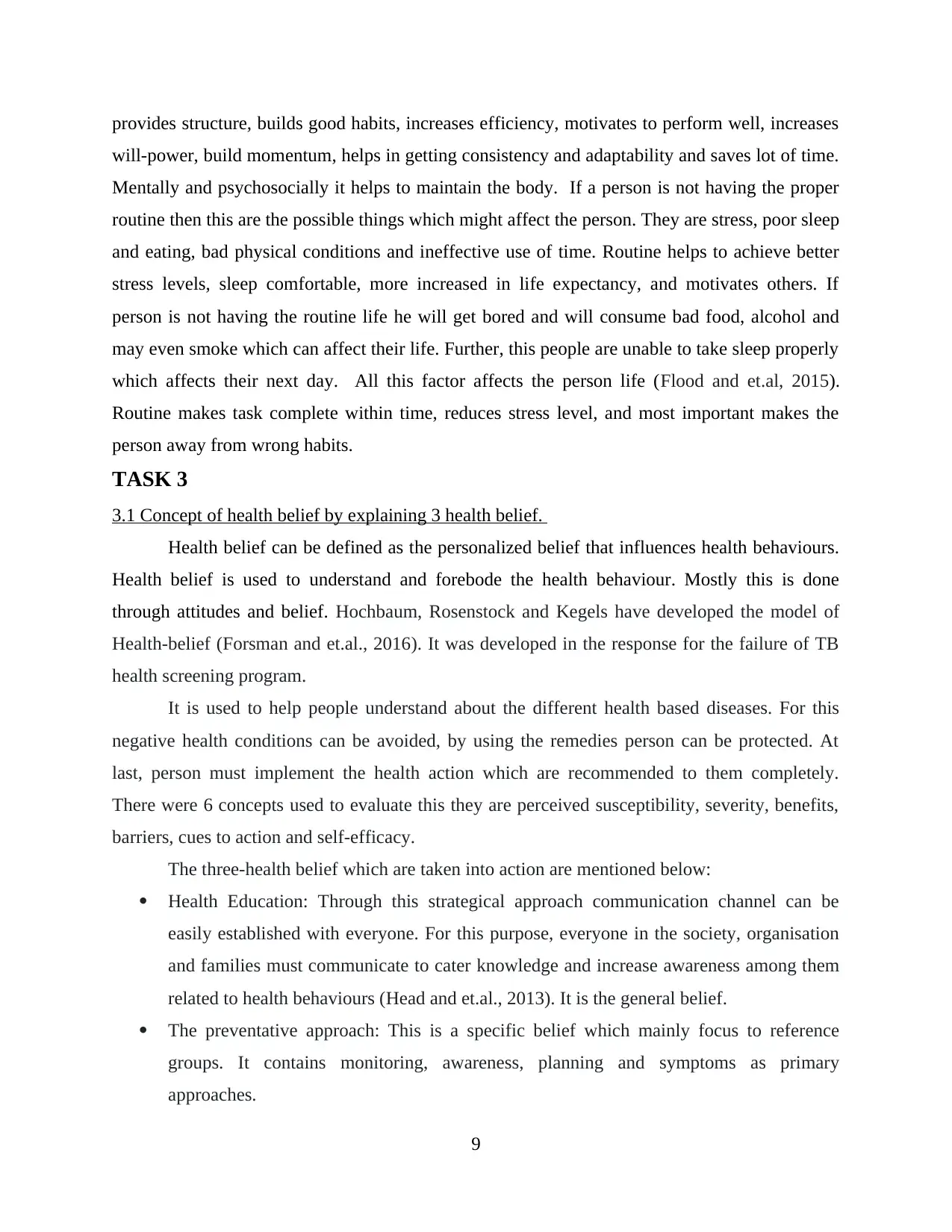
provides structure, builds good habits, increases efficiency, motivates to perform well, increases
will-power, build momentum, helps in getting consistency and adaptability and saves lot of time.
Mentally and psychosocially it helps to maintain the body. If a person is not having the proper
routine then this are the possible things which might affect the person. They are stress, poor sleep
and eating, bad physical conditions and ineffective use of time. Routine helps to achieve better
stress levels, sleep comfortable, more increased in life expectancy, and motivates others. If
person is not having the routine life he will get bored and will consume bad food, alcohol and
may even smoke which can affect their life. Further, this people are unable to take sleep properly
which affects their next day. All this factor affects the person life (Flood and et.al, 2015).
Routine makes task complete within time, reduces stress level, and most important makes the
person away from wrong habits.
TASK 3
3.1 Concept of health belief by explaining 3 health belief.
Health belief can be defined as the personalized belief that influences health behaviours.
Health belief is used to understand and forebode the health behaviour. Mostly this is done
through attitudes and belief. Hochbaum, Rosenstock and Kegels have developed the model of
Health-belief (Forsman and et.al., 2016). It was developed in the response for the failure of TB
health screening program.
It is used to help people understand about the different health based diseases. For this
negative health conditions can be avoided, by using the remedies person can be protected. At
last, person must implement the health action which are recommended to them completely.
There were 6 concepts used to evaluate this they are perceived susceptibility, severity, benefits,
barriers, cues to action and self-efficacy.
The three-health belief which are taken into action are mentioned below:
Health Education: Through this strategical approach communication channel can be
easily established with everyone. For this purpose, everyone in the society, organisation
and families must communicate to cater knowledge and increase awareness among them
related to health behaviours (Head and et.al., 2013). It is the general belief.
The preventative approach: This is a specific belief which mainly focus to reference
groups. It contains monitoring, awareness, planning and symptoms as primary
approaches.
9
will-power, build momentum, helps in getting consistency and adaptability and saves lot of time.
Mentally and psychosocially it helps to maintain the body. If a person is not having the proper
routine then this are the possible things which might affect the person. They are stress, poor sleep
and eating, bad physical conditions and ineffective use of time. Routine helps to achieve better
stress levels, sleep comfortable, more increased in life expectancy, and motivates others. If
person is not having the routine life he will get bored and will consume bad food, alcohol and
may even smoke which can affect their life. Further, this people are unable to take sleep properly
which affects their next day. All this factor affects the person life (Flood and et.al, 2015).
Routine makes task complete within time, reduces stress level, and most important makes the
person away from wrong habits.
TASK 3
3.1 Concept of health belief by explaining 3 health belief.
Health belief can be defined as the personalized belief that influences health behaviours.
Health belief is used to understand and forebode the health behaviour. Mostly this is done
through attitudes and belief. Hochbaum, Rosenstock and Kegels have developed the model of
Health-belief (Forsman and et.al., 2016). It was developed in the response for the failure of TB
health screening program.
It is used to help people understand about the different health based diseases. For this
negative health conditions can be avoided, by using the remedies person can be protected. At
last, person must implement the health action which are recommended to them completely.
There were 6 concepts used to evaluate this they are perceived susceptibility, severity, benefits,
barriers, cues to action and self-efficacy.
The three-health belief which are taken into action are mentioned below:
Health Education: Through this strategical approach communication channel can be
easily established with everyone. For this purpose, everyone in the society, organisation
and families must communicate to cater knowledge and increase awareness among them
related to health behaviours (Head and et.al., 2013). It is the general belief.
The preventative approach: This is a specific belief which mainly focus to reference
groups. It contains monitoring, awareness, planning and symptoms as primary
approaches.
9
⊘ This is a preview!⊘
Do you want full access?
Subscribe today to unlock all pages.

Trusted by 1+ million students worldwide
1 out of 18
Related Documents
Your All-in-One AI-Powered Toolkit for Academic Success.
+13062052269
info@desklib.com
Available 24*7 on WhatsApp / Email
![[object Object]](/_next/static/media/star-bottom.7253800d.svg)
Unlock your academic potential
Copyright © 2020–2025 A2Z Services. All Rights Reserved. Developed and managed by ZUCOL.





